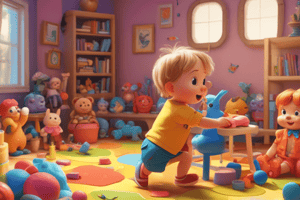Podcast
Questions and Answers
What developmental characteristic is primarily developed in children under age 3?
What developmental characteristic is primarily developed in children under age 3?
- Imagination
- Trust (correct)
- Problem-solving
- Independence
What stage of cognitive development, according to Piaget, is associated with children under age 3?
What stage of cognitive development, according to Piaget, is associated with children under age 3?
- Sensorimotor Stage (correct)
- Preoperational Stage
- Concrete Operational Stage
- Formal Operational Stage
What type of experiences are essential for the brain development of newborns?
What type of experiences are essential for the brain development of newborns?
- Visual stimulation from screens
- Structured educational activities
- Sensory and movement experiences (correct)
- Passive observation of surroundings
What is a key developmental theme for mobile toddlers and 2-year-olds?
What is a key developmental theme for mobile toddlers and 2-year-olds?
What type of materials are recommended for stimulating infants?
What type of materials are recommended for stimulating infants?
According to Erikson, what are the first two challenges faced by children under age 3?
According to Erikson, what are the first two challenges faced by children under age 3?
What is the primary role of practitioners in early childhood programs according to developmentally appropriate practice?
What is the primary role of practitioners in early childhood programs according to developmentally appropriate practice?
What question does the chapter conclude with regarding teachers' roles?
What question does the chapter conclude with regarding teachers' roles?
Flashcards
Trust (Erikson)
Trust (Erikson)
The ability to connect emotionally with others. It's the foundation of a child's sense of security in the world.
Autonomy (Erikson)
Autonomy (Erikson)
Becoming independent and self-sufficient. Children learn to assert their own desires and make choices.
Sensorimotor Stage (Piaget)
Sensorimotor Stage (Piaget)
The stage where babies learn through their senses and physical actions. They explore the world by touching, tasting, and moving.
Exploration Play
Exploration Play
Signup and view all the flashcards
Oral Language in Exploration Play
Oral Language in Exploration Play
Signup and view all the flashcards
Symbolic Play
Symbolic Play
Signup and view all the flashcards
Developmentally Appropriate Practice (DAP)
Developmentally Appropriate Practice (DAP)
Signup and view all the flashcards
Self-Chosen Play
Self-Chosen Play
Signup and view all the flashcards
Study Notes
Stages of Play
- Play of 3-5 year olds differs from younger children
- Developmentally appropriate practices in early childhood programs are important
- Decisions in early childhood programs should reflect characteristics of development, learning, and interactions
- Environments, materials, experiences, and interactions should be relevant and meaningful
Under Three: Exploration
- Erikson (1950) describes exploration as a challenge for children under age 3
- Trust and autonomy are key development aspects
- Piaget (Peterson & Felton-Collins, 1986) describes the sensorimotor stage, where learning is based on physical experiences
- Neuroscience research shows that newborns' brains are shaped by sensory and movement
- Babies need unrestricted movement and access to various textures and materials (papers, fabrics, balls)
- Toddlers explore through physical action and developing oral language
- Exploration includes interactions with adults and the environment, and communication through experimenting with different objects
- Caregivers should create environments rich in sensory experiences to facilitate exploration and communication skills.
- Caregivers should use child-appropriate language and teach problem-solving.
Studying That Suits You
Use AI to generate personalized quizzes and flashcards to suit your learning preferences.




